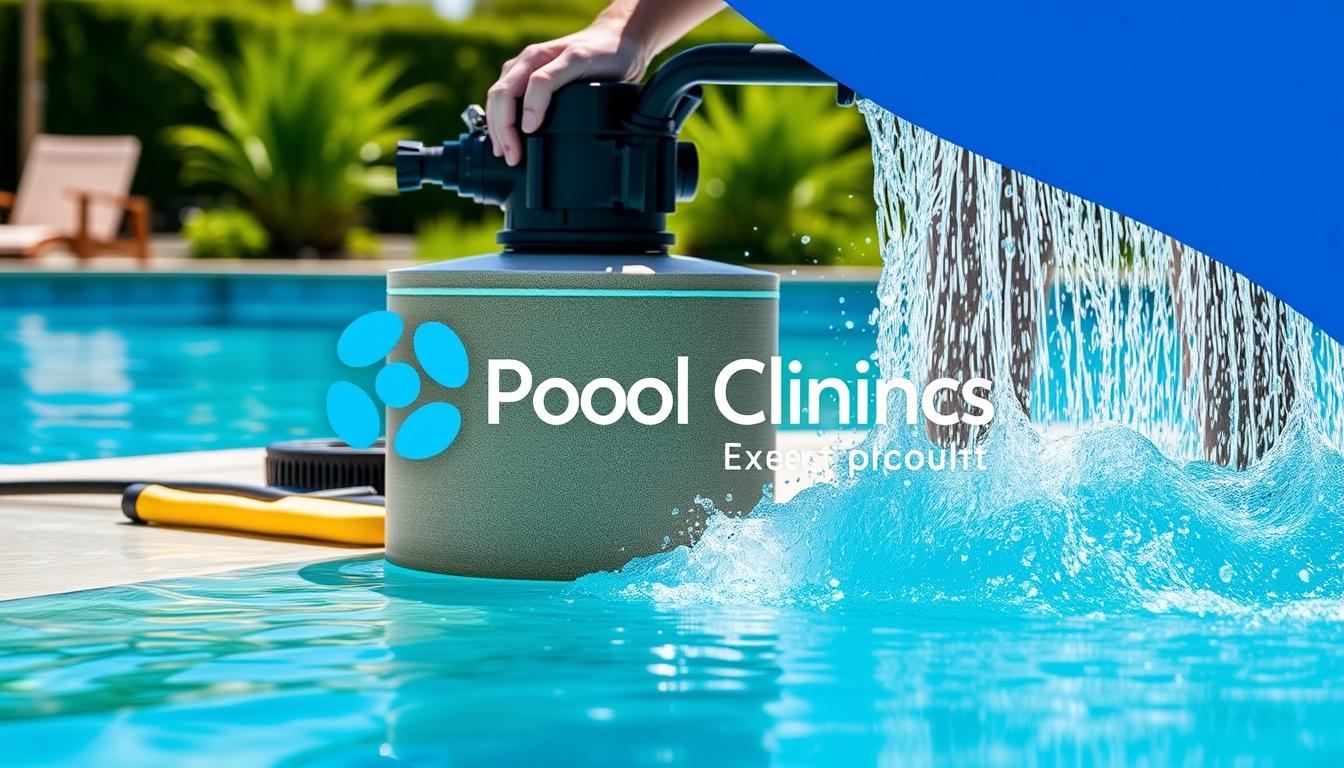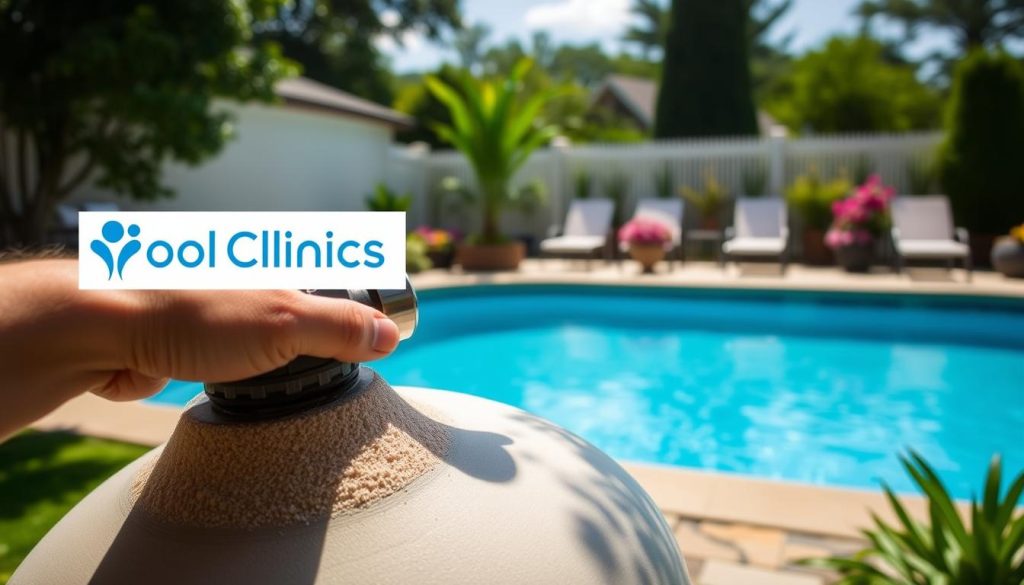
Pool owners love relaxing by their crystal-clear backyard oasis. Diving into a sparkling pool on a hot day is pure bliss. However, maintaining that pristine clarity requires regular care, especially for pool filter systems.
Sand filters are known for their durability and ease of use. Yet, even these reliable workhorses need attention to keep pools looking their best.
Imagine preparing for a swim, only to find cloudy water and weak jets. Your sand filter likely needs cleaning. Don’t worry! We’ll explore sand filter cleaning and maintenance.
You’ll learn how these filters work and master the art of backwashing. Get ready to keep your pool water shimmering all season long!
Key Takeaways:
- Sand filters capture particles down to 20-40 microns, ensuring clean and clear pool water.
- Regular backwashing is crucial when the filter pressure rises 25% over the clean pressure baseline.
- Deep cleaning a sand filter annually prevents channeling and maintains optimal filtration performance.
- Monitoring the pressure gauge and performing regular maintenance are key to effective sand filter operation.
- Proper safety precautions, such as turning off the pump and using protective gear, are essential during pool maintenance tasks.
Understanding Sand Pool Filters
Sand pool filters are common in pools. They’re simple, durable, and effective. These filters use #20 silica sand to trap particles. The sand size ranges from 0.45 to 0.55 mm.

How Sand Filters Work
Sand filters push water through a sand layer. This sand traps dirt and debris. Clean water then flows back into the pool.
Over time, debris can clog the filter. This reduces efficiency and increases system pressure. Backwashing is needed to flush out trapped debris.
Importance of Regular Cleaning and Maintenance
Regular cleaning keeps sand filters working well. It also extends the system’s lifespan. Sand filters typically last five to eight years.
The sand needs changing every three to five years. This maintains filtration efficiency. Proper maintenance tips for pool filters include:
- Regular cleaning and backwashing
- Maintaining proper water chemistry
- Daily skimming and vacuuming of the pool
- Inspecting the pool for leaks
Following these pool maintenance tips keeps sand filters working well. It helps avoid issues like cloudy water and algae growth.
Consequences of Ineffective Filtration
Neglecting pool sand filter maintenance can cause problems. These issues affect the pool’s health and appearance. Some consequences of poor filtration include:
| Consequence | Description |
|---|---|
| Cloudy water | Inadequate filtration can cause the pool water to become cloudy and unappealing. |
| Algae growth | Poor filtration can create an environment conducive to algae growth, leading to green or murky water. |
| Reduced water flow | Clogged filters can restrict water flow, putting additional strain on the pool’s circulation system. |
| Increased energy consumption | Inefficient filtration can cause the pool pump to work harder, consuming more energy and increasing operating costs. |
“A slightly dirty sand filter works better at capturing and filtering particles, and backwashing should only be performed when the filter pressure rises 25% over the baseline clean pressure.”
Understanding pool sand filter maintenance is crucial. Addressing sand filter troubleshooting issues quickly ensures a clean pool. This creates a healthy swimming environment for everyone.
Step-by-Step Guide: How to Clean a Sand Filter
Cleaning your sand filter keeps your pool healthy and sparkling. Follow these steps to ensure your filter works efficiently. This process will keep your pool water clear and free of contaminants.
Regular maintenance is key to a clean pool. Let’s explore how to clean your sand filter effectively.
Backwashing: The Key to Effective Cleaning
Backwashing is the main way to clean sand filters. First, turn off your pool pump. Set the filter valve to “Backwash”.
Turn the pump back on. Let it run for 2-3 minutes or until the sight glass water is clear. This process flushes out debris and contaminants.
Consider cleaning the filter if there is a significant increase in the pressure gauge reading, typically over 8 PSI above the normal operating level.
Rinse and Return to Filter Mode
After backwashing, rinse the sand filter. This settles the sand bed and removes any leftover dirt. Set the filter valve to “Rinse” and run the pump for about a minute.
This step prevents debris from re-entering your pool. Once done, turn off the pump. Set the valve back to “Filter” position.
Monitoring Pressure Gauge and Regular Maintenance
Keep an eye on the pressure gauge regularly. After cleaning, the gauge should read lower. This indicates a successful clean.
If pressure increases by 8-10 PSI above normal, it’s time to backwash again. Aim to backwash your sand filter at least once a month.
| Filter Type | Recommended Cleaning Frequency |
|---|---|
| Sand Filters | Every 3-5 years |
| Cartridge Filters | Every 2 weeks |
| DE Filters | Once per season |
Different filters need cleaning at different times. Check the table above for guidance. Regular cleaning extends your pool equipment’s life.
A consistent cleaning schedule ensures a healthier swimming environment. Your family and friends will enjoy a cleaner, safer pool.
- Turn off the pool pump and set the filter valve to “Backwash”
- Turn on the pump and run for 2-3 minutes or until water in sight glass is clear
- Set the valve to “Rinse” and run the pump for 1 minute
- Turn off the pump and set the valve back to “Filter”
- Monitor pressure gauge and backwash as needed, typically when pressure increases 8-10 PSI above normal operating level
Conclusion
Follow these pool maintenance tips to keep your sand filter working well. Proper care ensures clean, inviting water and prevents costly repairs. Backwash your filter every 1-4 weeks and replace sand every 5-7 years.
Monitor the pressure gauge and watch for signs of needed replacements. Look for visible damage, reduced water flow, or increased pressure. Choose compatible parts sized correctly for your filter brand.
Optimize water circulation and use a robotic pool cleaner to enhance sand filter effectiveness. These strategies help keep your pool clean with minimal effort.
With consistent care and attention, you’ll enjoy a beautiful swimming environment all season. Your pool will stay sparkling clean and healthy for everyone to enjoy.







